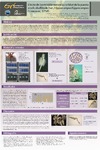Identificador persistente para citar o vincular este elemento:
https://accedacris.ulpgc.es/jspui/handle/10553/5852
| Campo DC | Valor | idioma |
|---|---|---|
| dc.contributor.author | Otero-Ferrer, Francisco | en_US |
| dc.contributor.author | Molina-Domínguez, Lucía | en_US |
| dc.contributor.author | Socorro Cruz, Juan Antonio | en_US |
| dc.contributor.author | Herrera-Pérez, Rogelio | en_US |
| dc.contributor.author | Fernandez-Palacios, H. | en_US |
| dc.contributor.author | Izquierdo, Marisol | en_US |
| dc.date.accessioned | 2011-07-19T02:31:00Z | - |
| dc.date.accessioned | 2018-06-18T06:49:34Z | - |
| dc.date.available | 2011-07-19T04:01:12Z | - |
| dc.date.available | 2018-06-18T06:49:34Z | - |
| dc.date.issued | 2009 | en_US |
| dc.identifier.uri | https://accedacris.ulpgc.es/handle/10553/5852 | - |
| dc.description.abstract | The importance of a suitable feeding in reproduction and spawning quality of teleost fish has been recognized as one of the major ?bottlenecks? in new aquaculture species like seahorses. Mysidacea species has been described as one of the main food for temperate seahorse species (Hippocampus hippocampus and H. guttulatus) in the wild. On the other hand, Artemia has been employed usually as marine food for rearing fish, including seahorses. The aim of this work is to study the effect of two different live preys (Artemia vs Mysis) in spawning quality of H. hippocampus broodstock. The animals were fed two times per day, six times per week. Spawning episodes and larvae quality was recorded. Seahorse fed on mysis showed significantly better results (p<0.05) than Artemia treatment, regarding spawning events, number of offspring?s and size. This fact showed the high potential of mysis as live prey for seahorses or other ornamental species. | en_US |
| dc.format | application/pdf | es |
| dc.language | spa | en_US |
| dc.rights | by-nc-nd | es |
| dc.source | XII Congreso Nacional de Acuicultura, Madrid 24-26, Noviembre 2009 | en_US |
| dc.subject | 310502 Piscicultura | en_US |
| dc.subject.other | Misidáceos | en_US |
| dc.subject.other | Caballito de mar | en_US |
| dc.subject.other | Hippocampus hippocampus | en_US |
| dc.title | Efecto de los misidáceos en la calidad de la puesta en el caballito de mar, Hippocampus hippocampus (Linnaeus, 1758) | en_US |
| dc.type | info:eu-repo/semantics/conferenceobject | en_US |
| dc.type | Conference poster | en_US |
| dc.identifier.absysnet | 628998 | - |
| dc.investigacion | Ciencias | en_US |
| dc.rights.accessrights | info:eu-repo/semantics/openAccess | es |
| dc.type2 | Póster de congresos | en_US |
| dc.utils.revision | Sí | en_US |
| dc.identifier.ulpgc | Sí | en_US |
| item.fulltext | Con texto completo | - |
| item.grantfulltext | open | - |
| crisitem.author.dept | GIR ECOAQUA: Biodiversidad y Conservación | - |
| crisitem.author.dept | IU de Investigación en Acuicultura Sostenible y Ecosistemas Marinos (IU-Ecoaqua) | - |
| crisitem.author.dept | Departamento de Biología | - |
| crisitem.author.dept | GIR Grupo de Investigación en Acuicultura | - |
| crisitem.author.dept | IU de Investigación en Acuicultura Sostenible y Ecosistemas Marinos (IU-Ecoaqua) | - |
| crisitem.author.dept | Departamento de Biología | - |
| crisitem.author.orcid | 0000-0002-1328-9662 | - |
| crisitem.author.orcid | 0000-0003-1410-8154 | - |
| crisitem.author.orcid | 0000-0003-4297-210X | - |
| crisitem.author.parentorg | IU de Investigación en Acuicultura Sostenible y Ecosistemas Marinos (IU-Ecoaqua) | - |
| crisitem.author.parentorg | IU de Investigación en Acuicultura Sostenible y Ecosistemas Marinos (IU-Ecoaqua) | - |
| crisitem.author.fullName | Otero Ferrer, Francisco José | - |
| crisitem.author.fullName | Fernández Palacios, Hipólito | - |
| crisitem.author.fullName | Izquierdo López, María Soledad | - |
| Colección: | Póster de congreso | |
Los elementos en ULPGC accedaCRIS están protegidos por derechos de autor con todos los derechos reservados, a menos que se indique lo contrario.
